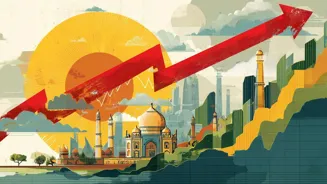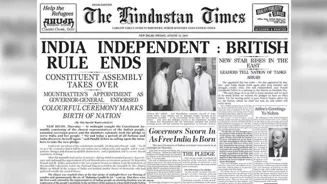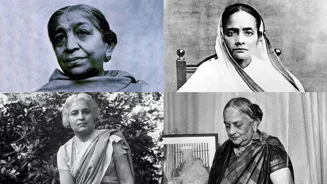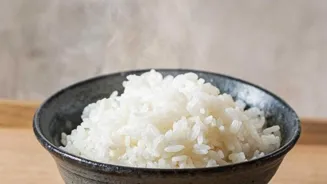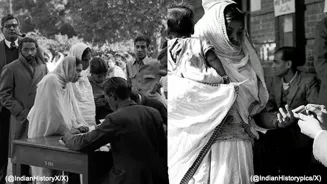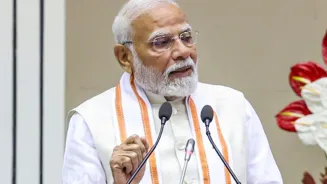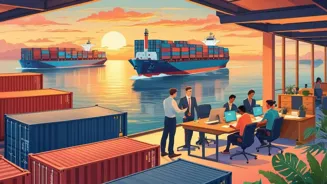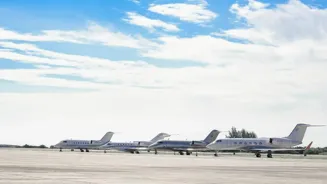What is the story about?
On the midnight of August 15, 1947, Jawaharlal Nehru’s words echoed through the newly sovereign Parliament of India. In his now-iconic “Tryst with Destiny” speech, he spoke of awakening to life and freedom. But what he didn’t say
that night was that India was stepping into independence with empty coffers, a battered economy and a people weighed down by poverty and hunger.
The British exit left behind a country divided, looted, and hollowed out. For centuries, the subcontinent had been one of the wealthiest regions in the world — in 1700, it accounted for nearly 24 per cent of global GDP, earning the name “the Golden Bird.” By the time the Union Jack was lowered in 1947, that figure had collapsed to under 4 per cent. Famines had scarred the land, railways served colonial extraction rather than
domestic needs, and industrial development was stifled.
Life expectancy was a mere 32 years, literacy stood at 12 per cent, and food shortages were rampant. Before India could dream of prosperity, it first had to survive.
In the first decades after independence, scarcity was the default setting for most Indians. Prime Minister Nehru, a man of science and idealism, believed that state-led industrialisation would build the foundations of a modern economy. Inspired by the Soviet model, India introduced
Five-Year Plans to guide production, decide priorities and allocate resources.
Steel plants, dams, and public-sector banks rose from the ground. But the same system also created the Licence Raj — a maze of approvals and permits that strangled private enterprise. To open a factory, one needed political connections. A scooter could have a waiting list of ten years. A household telephone might take seven years to arrive. Foreign goods were almost entirely out of reach.
Between 1950 and 1980, India’s GDP
grew at an annual rate of just 3.5% — what economists dubbed the “Hindu rate of growth.” At that pace, it would take decades to double national income. Yet, amid the economic sluggishness, there were glimmers of progress.
Green Revolution and Self-Reliance in Food
The Green Revolution of the 1960s transformed India’s agricultural landscape. Facing the threat of recurring famine, the country adopted high-yield seeds, modern irrigation, and fertilisers. Within a decade, India went from importing wheat from the United States to being
self-sufficient in food grains.
But even with improved food security, poverty remained widespread. In 1980, India’s per capita income was lower than Sudan’s, a stark measure of its economic challenges. The time was ripe for change.
Rajiv Gandhi’s arrival as Prime Minister in the mid-1980s brought a wave of cautious liberalisation. The young, tech-savvy leader deregulated the textile industry, introduced computers to government offices, and prioritised telecommunications. Growth climbed to
5–6 per cent, and urban India began to see signs of prosperity. Families bought their first Maruti Suzuki cars, colour televisions became common, and live cricket united the nation via Doordarshan broadcasts.
But beneath this modest boom lay a brewing crisis. By 1991, India was heavily in debt, inflation was high, and foreign exchange reserves had plummeted to a level that could cover only two weeks of imports. In a desperate measure, the government airlifted its gold reserves to London as collateral for emergency loans.
The 1991 balance-of-payments crisis forced India to seek a $2.2 billion bailout from the International Monetary Fund. The loan came with conditions — India had to dismantle many of its socialist-era restrictions.
Under prime minister PV Narasimha Rao and finance minister Manmohan Singh, the government took a bold step. The Licence Raj was dismantled, the rupee devalued, trade barriers reduced and foreign companies welcomed. Private enterprises were finally free from the web of permissions and
quotas.
The results were swift. GDP growth rebounded to 5.5 per cent in the first year. Exports surged, and a new entrepreneurial class began to emerge.
By the early 2000s, India had carved a new identity — the world’s IT powerhouse. Cities like Bengaluru, Hyderabad and Pune became global hubs for software development and back-office operations. Companies like Infosys, TCS and Wipro became international names.
Between 2003 and 2008, GDP growth averaged 8.8 per cent. The middle
class expanded, shopping malls multiplied, and air travel became increasingly common. Indians queued for their first iPhones, foreign investment poured in and the nation seemed unstoppable.
When the 2008 financial crisis rocked economies worldwide, India stumbled but did not fall. By 2010, GDP growth had bounced back to 9 per cent, even overtaking China in some quarters. The momentum continued for much of the next decade, fuelled by a booming services sector, rising consumption and an explosion of
smartphone use.
By 2019, economic growth was slowing. Then, in 2020, the Covid-19 pandemic hit. Lockdowns brought life to a standstill, demand collapsed, and GDP contracted by 7.3 per cent — the worst in nearly four decades.
Yet India’s recovery was just as dramatic. In 2021, growth rebounded to 9 per cent, powered by mass vaccination drives, record exports and rapid tech adoption. UPI digital transactions skyrocketed, online education went mainstream, and rural consumption revived.
By 2025, India crossed the $4 trillion GDP mark, overtaking Japan to become the world’s fourth largest economy — just behind Germany. Services now contribute over 50 per cent of GDP, manufacturing about 28 per cent, and agriculture around 13 per cent.
In 1947, India’s per capita income was about Rs 250 a year; in 2025, it’s close to Rs 2 lakh. The transformation is staggering.
The India of 1947 struggled to feed itself; today, it exports food
to the world. It is the largest exporter of rice, the biggest milk producer, and a significant supplier of wheat, pulses, spices and sugar.
Electricity, once imported, is now exported to neighbours like Nepal and Bangladesh. In pharmaceuticals, India is the “pharmacy of the world,” producing 70 per cent of global vaccines and exporting medicines worth over $30 billion annually. Life expectancy has more than doubled since independence.
Since 1990, India has
witnessed remarkable growth across multiple sectors. The number of cars per 1,000 people has jumped from just five in 1990 to over 30 in 2025, making India the third-largest car market globally. It has also become the second-largest smartphone market, with hundreds of millions of users. The aviation industry has seen a massive expansion, growing from 14 million flyers in 2001 to 174 million in 2024, positioning India as the third-largest aviation market. International travel has surged as well, with 30 million Indians flying abroad in 2024 compared to just 4.4 million in 2000. In the digital payments space, UPI processed an astounding 172 billion transactions in 2024—five times Visa’s global volume.
India’s economic journey is remarkable, but the road ahead is not without obstacles. Inequality remains stark; rural distress persists while billionaires multiply. Unemployment is a silent crisis. Climate change poses existential threats to agriculture, infrastructure and coastal cities.
Yet India holds one powerful card — its youth. Nearly half of its 1.4 billion
citizens are under 30. If the country can educate, employ, and empower them, it could script a second freedom story — one of economic self-determination.
India’s story since 1947 is one of grit, resilience, and reinvention. From famine to forex surpluses, from telegrams to terabytes, from postcolonial poverty to post-pandemic promise — the nation has fought as hard for prosperity as it once fought for freedom.
The Golden Bird is airborne again, and this journey is far
from over.
The British exit left behind a country divided, looted, and hollowed out. For centuries, the subcontinent had been one of the wealthiest regions in the world — in 1700, it accounted for nearly 24 per cent of global GDP, earning the name “the Golden Bird.” By the time the Union Jack was lowered in 1947, that figure had collapsed to under 4 per cent. Famines had scarred the land, railways served colonial extraction rather than
Life expectancy was a mere 32 years, literacy stood at 12 per cent, and food shortages were rampant. Before India could dream of prosperity, it first had to survive.
Years of scarcity: 1950s–1970s
In the first decades after independence, scarcity was the default setting for most Indians. Prime Minister Nehru, a man of science and idealism, believed that state-led industrialisation would build the foundations of a modern economy. Inspired by the Soviet model, India introduced
Steel plants, dams, and public-sector banks rose from the ground. But the same system also created the Licence Raj — a maze of approvals and permits that strangled private enterprise. To open a factory, one needed political connections. A scooter could have a waiting list of ten years. A household telephone might take seven years to arrive. Foreign goods were almost entirely out of reach.
Between 1950 and 1980, India’s GDP
Green Revolution and Self-Reliance in Food
The Green Revolution of the 1960s transformed India’s agricultural landscape. Facing the threat of recurring famine, the country adopted high-yield seeds, modern irrigation, and fertilisers. Within a decade, India went from importing wheat from the United States to being
But even with improved food security, poverty remained widespread. In 1980, India’s per capita income was lower than Sudan’s, a stark measure of its economic challenges. The time was ripe for change.
A young leader’s experiments: 1980–1990
Rajiv Gandhi’s arrival as Prime Minister in the mid-1980s brought a wave of cautious liberalisation. The young, tech-savvy leader deregulated the textile industry, introduced computers to government offices, and prioritised telecommunications. Growth climbed to
But beneath this modest boom lay a brewing crisis. By 1991, India was heavily in debt, inflation was high, and foreign exchange reserves had plummeted to a level that could cover only two weeks of imports. In a desperate measure, the government airlifted its gold reserves to London as collateral for emergency loans.
1991: Crisis that changed everything
The 1991 balance-of-payments crisis forced India to seek a $2.2 billion bailout from the International Monetary Fund. The loan came with conditions — India had to dismantle many of its socialist-era restrictions.
Under prime minister PV Narasimha Rao and finance minister Manmohan Singh, the government took a bold step. The Licence Raj was dismantled, the rupee devalued, trade barriers reduced and foreign companies welcomed. Private enterprises were finally free from the web of permissions and
The results were swift. GDP growth rebounded to 5.5 per cent in the first year. Exports surged, and a new entrepreneurial class began to emerge.
IT boom and the new millennium
By the early 2000s, India had carved a new identity — the world’s IT powerhouse. Cities like Bengaluru, Hyderabad and Pune became global hubs for software development and back-office operations. Companies like Infosys, TCS and Wipro became international names.
Between 2003 and 2008, GDP growth averaged 8.8 per cent. The middle
Weathering the 2008 global financial crisis
When the 2008 financial crisis rocked economies worldwide, India stumbled but did not fall. By 2010, GDP growth had bounced back to 9 per cent, even overtaking China in some quarters. The momentum continued for much of the next decade, fuelled by a booming services sector, rising consumption and an explosion of
Pandemic shock and a fierce comeback
By 2019, economic growth was slowing. Then, in 2020, the Covid-19 pandemic hit. Lockdowns brought life to a standstill, demand collapsed, and GDP contracted by 7.3 per cent — the worst in nearly four decades.
Yet India’s recovery was just as dramatic. In 2021, growth rebounded to 9 per cent, powered by mass vaccination drives, record exports and rapid tech adoption. UPI digital transactions skyrocketed, online education went mainstream, and rural consumption revived.
2025: Fourth largest economy
By 2025, India crossed the $4 trillion GDP mark, overtaking Japan to become the world’s fourth largest economy — just behind Germany. Services now contribute over 50 per cent of GDP, manufacturing about 28 per cent, and agriculture around 13 per cent.
In 1947, India’s per capita income was about Rs 250 a year; in 2025, it’s close to Rs 2 lakh. The transformation is staggering.
From shortages to surpluses
The India of 1947 struggled to feed itself; today, it exports food
Electricity, once imported, is now exported to neighbours like Nepal and Bangladesh. In pharmaceuticals, India is the “pharmacy of the world,” producing 70 per cent of global vaccines and exporting medicines worth over $30 billion annually. Life expectancy has more than doubled since independence.
Changing lifestyles: By the numbers
Since 1990, India has
Promise and challenges
India’s economic journey is remarkable, but the road ahead is not without obstacles. Inequality remains stark; rural distress persists while billionaires multiply. Unemployment is a silent crisis. Climate change poses existential threats to agriculture, infrastructure and coastal cities.
Yet India holds one powerful card — its youth. Nearly half of its 1.4 billion
From bullock carts to bullet trains
India’s story since 1947 is one of grit, resilience, and reinvention. From famine to forex surpluses, from telegrams to terabytes, from postcolonial poverty to post-pandemic promise — the nation has fought as hard for prosperity as it once fought for freedom.
The Golden Bird is airborne again, and this journey is far
Do you find this article useful?
